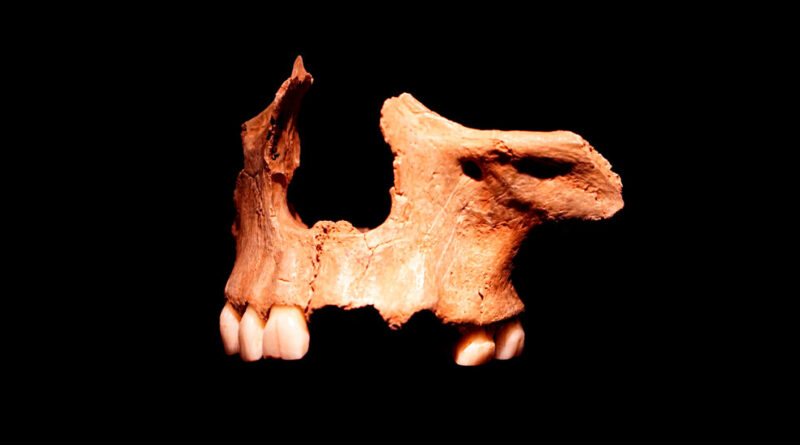When Is a Cannibal Not a Cannibal?
[ad_1]
Everybody’s quick to see a cannibal. The Romans thought the ancient Britons feasted on human flesh, and the British thought the same about the Irish. Not a few prehistoric finds have been attributed, evocatively if not accurately, to the work of ancient cannibals. In 1871, Mark Twain commented on the discovery of the bones of a primeval man who purportedly had been made a meal of by his peers: “I ask the candid reader, Does not this look like taking advantage of a gentleman who has been dead two million years?”
In today’s scholar-eat-scholar world of paleoanthropology, claims of cannibalism are held to exacting standards of evidence. Which is why more than a few eyebrows were raised earlier this week over a study in Scientific Reports asserting that a 1.45-million-year-old fragment of shin bone — found 53 years ago in northern Kenya, and sparsely documented — was an indication that our human ancestors not only butchered their own kind, but were probably, as an accompanying news release put it, “chowing down” on them, too.
The news release described the finding as the “oldest decisive evidence” of such behavior. “The information we have tells us that hominids were likely eating other hominids at least 1.45 million years ago,” Briana Pobiner, a paleoanthropologist at the Smithsonian’s National Museum of Natural History and first author of the paper, said in the news release. “There are numerous other examples of species from the human evolutionary tree consuming each other for nutrition, but this fossil suggests that our species’ relatives were eating each other to survive further into the past than we recognized.”
The discovery of a portion of the presumed victim threw into relief one of the questions that keep paleoanthropologists up at night: When do marks on a bone indicate cannibalism? Or, put another way, How much premodern evidence is needed to prove a modern theory?
Dr. Pobiner, an authority on cut marks, had spied the half-tibia fossil six summers ago while examining hominid bones housed in a Nairobi museum vault. She was inspecting the fossil for bite marks when she noticed 11 thin slashes, all angled in the same direction and clustered around a spot where a calf muscle would have attached to the bone — the meatiest chunk of the lower leg, Dr. Pobiner said in an interview.
She sent molds of the scars to Michael Pante, a paleoanthropologist at Colorado State University and an author on the study, who made 3-D scans and compared the shape of the incisions with a database of 898 tooth, trample and butchery marks. The analysis indicated that nine of the markings were consistent with the kind of damage made by stone tools. Dr. Pobiner said that the placement and orientation of the cuts implied that flesh had been stripped from the bone. From those observations she extrapolated her cannibalism thesis.
“From what we can tell, this hominin leg bone is being treated like other animals, which we presume are being eaten based on lots of butchery marks on them,” Dr. Pobiner said. “It makes the most sense to presume that this butchery was also done for the purpose of eating.”
In the study, Dr. Pobiner wrote that cannibalism was one possible explanation for the defleshed bone. But her quotes in the news release sounded more definitive and, to the chagrin of colleagues, inspired headlines such as “YABBA DABBA CHEW! Cavemen were butchering and eating each other 1.45 million years ago, scientists say.”
Some experts praised the findings. “Thoughtful and perfectly pitched,” said James Cole, an archaeologist at the University of Brighton. Others called Dr. Pobiner’s case for prehistoric cannibalism overstated, if only because she offered no proof that the flesh had been eaten. “If they are butchery marks, we cannot be confident about cannibalism,” said Raphaël Hanon, a zooarchaeologist at University of the Witwatersrand, Johannesburg.
“Clickbait,” said Tim D. White, a paleoanthropologist at the University of California, Berkeley, who is best known for leading the team that discovered Ardipithecus ramidus, a 4.4 million-year-old likely human forebear. “Even if they are eventually demonstrated to be both ancient and real, the simple presence of ambiguous scratches on an isolated fossil bone is not sufficient evidence of cannibalism.”
More often that not, verification of the practice is open to doubt. “Archaeologists and physical anthropologists try hard to make their fields ‘real’ hard science, but the further back you go, the foggier the data gets,” said Peter Bullock, a retired chief archaeologist for the U.S. Army Corps of Engineers. “Cannibalism is usually the sexy interpretation, and one I spent a lot of energy discounting. Why not a murder victim or the result of an autistic humanoid doing self-harm? Prove that’s not possible.”
Controversy over ancient anthropophagy, or cannibalism, has raged in academia for more than a century. In 1925, Raymond Dart, an anatomist at the University of the Witwatersrand, announced the discovery of a partial skull of an apelike juvenile excavated from a quarry in the town of Taung. He named the prehuman species Australopithecus africanus — the southern ape of Africa.
Largely from the look of the skull, Dr. Dart deduced that the child had died from a heavy blow to the head, and concluded that at least some australopithecines were “confirmed killers: carnivorous creatures, that seized living quarries by violence, battered them to death, tore apart their broken bodies, dismembered them limb for limb, slaking their ravenous thirst with the hot blood of victims and greedily devouring livid writhing flesh.” Scientists now suspect that the so-called Taung Child, who died 2.8 million years ago, was killed by an eagle or another large predatory bird, citing puncture marks found at the bottom of the 3-year-old’s eye sockets.
Scholars have long debated whether to accept routine, habitual cannibalism in human prehistory, or to deny that it has ever occurred in the human family tree. “If you’re fighting for survival, which our ancestors did every single day, any source of nutrition would have been beneficial,” said Dr. Pante. The polemic intensified in 1979, when William Arens, a social anthropologist, argued in his book “The Man-Eating Myth: Anthropology and Anthropophagy” that there was almost no reliable historical and ethnographical evidence for the custom of cannibalism, except in isolated, dire emergencies.
“Cannibalism has a sporadic revival whenever there are no anthropologists to observe it,” Dr. Arens wrote. He asserted that pretty much all accounts of cannibalism are hearsay, a propaganda tool by scholars of the British Empire to help tame the ignoble savage.
“Not much of Arens’ book stands today,” said Dr. White, the paleoanthropologist, “but it proved a useful heuristic device for its time and a challenge to those interested in the nature and extent of cannibalism in the recent and deep past.” Perhaps the book’s most lasting influence, he added, was to compel academics to raise the standards of their evidence and scholarship.
Since then, clear proof of systematic cannibalism among hominids has emerged in the fossil record. The earliest confirmation was uncovered in 1994 in the Gran Dolina cave site of Spain’s Atapuerca Mountains. The remains of 11 individuals who lived some 800,000 years ago displayed distinctive signs of having been eaten, with bones displaying cuts, fractures where they had been cracked open to expose the marrow and human tooth marks.
Among our other evolutionary cousins now confirmed to have practiced cannibalism are Neanderthals, with whom humans overlapped, and mated, for thousands of years. A study published in 2016 reported that Neanderthal bones found in a cave in Goyet, Belgium, and dated to roughly 40,000 B.C. show signs of being butchered, split and used to sharpen the edges of stone tools. Patterns of bone-breakage in Homo antecessor, considered the last common ancestor of Neanderthals and Homo sapiens, suggest that cannibalism goes back a half-million years or more.
Dr. Pobiner’s bone fragment specimen was retrieved by Mary Leakey, a British paleoanthropologist, in the remote desert badlands just east of Lake Turkana, then called Lake Rudolf, without an archaeological context of the fauna that was observed at the time of discovery. “Were there other cut-marked bones?” Dr. White said. “Were there stone tools? Have the investigators tried to return to the site to find the other end of the tibia?” He maintained that those details are critical to providing accurate inferences about past events.
So, when do marks on a bone indicate prehistoric cannibalism? “On a single bone, never,” Dr. White said. “Demonstrating that the scratches were made by a hominid using a stone tool is a methodological challenge. The larger challenge is to demonstrate that such evidence has anything whatsoever to do with cannibalism.”
[ad_2]
Source link


